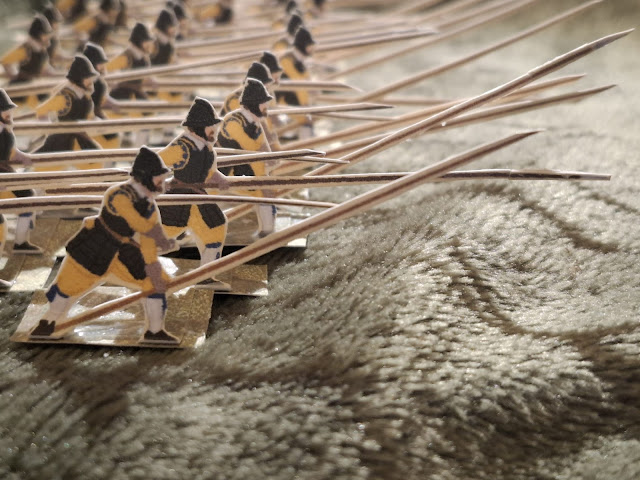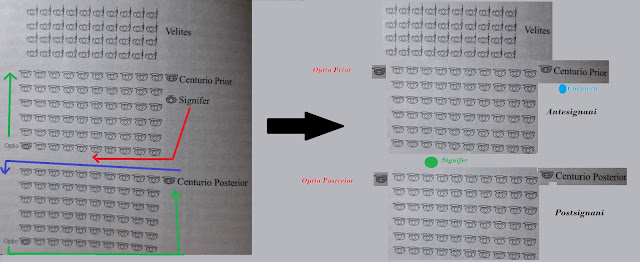I always wanted to postpone this topic, in order to have 1 legion at 1:1 ratio to show. But I think this is a long time ahead and I cannot resist to share with you what I have learned from my researches. Above all, because Italian books on this topic are far better and better detailed - as you will see in the next lessons - than the English written books.
I am indeed preparing a "Polybian" Legion (Polybius was the Greek writer, contemporary to the Republican Legion that better described how a Legion worked) at 1:1 ratio, but my numbers are still very small (I am preparing at the same time the 3rd Battle of Ramla and the Battle of Turin 1706); so I need a lot of time to complete my purpose.
The first point to be pointed out immediatly is that no one ever described precisely how a Republican Legion actually worked. There are theories (mostly wrong) about the triple acies, but it is not clear how it actually worked, as said.
The Italian books that I will quote are the unique indeed that with a comparision of different passages (quoted in Latin or Ancient Greek) are able to give an idea of the way it worked. This will solve one an for ever the numbers of a Legion and a lot of other problems. The rest will be up to me and to my 1:1 ratio papersoldier Legion.
Let's start from the number and position of the "Signum" (insign), plural "Signa" inside the maniple. And let's start from the Osprey "Roman Republican Legionary - 298 - 105 BC"

As it happens sometimes with Osprey the lack of space in details creates some problems in explaining well the topic. As usual pictures are superbe, but something with "Signa" is wrong.
At page 23 it is reported (please read underlined in red): "each century carried ist own standard (signum) ...omissis ... each centuroi was supported by four subordinates, a second in command (optio) a standard-beared (signifer) ....omissis Polybios says the Centurions choose from the ranks two of their bravest men to be the standard-beares for each maniple. AS THERE WAS ONLY ONE SIGNUM PER MANIPLE ....
So the text contradicts itself in few rows: at the top it say that every century had a standard. Though a maniple was formed by 2 centuries it means that every maniple (2 centuries) had 2 signa; but later, just few rows down it states (correctly) that there was only 1 signum per maniple, so 1 every 2 centuries. This points out very clearly the mistake the Author incurred in this case.
As it will better related later, it is correct that every maniple carried its own signum, also because the century (centuria in Latin) was just an administrative unit and not a fighiting unit. The 2 centuries (Centuriae plural in Latin) were differentiated as Centuria Anterior (front Century) and Centuria Posterior (Back Century); in between them there was the "Signifer" (from signum-ferre i.e. the transporter of the signum); in fact the legionaries in the front century were called "Antesignani" i.e. "those that are before the signum and the legionaries in the back century were called "Postsignani", i.e. those that are bihind the signum.
It is correct that the Signifer had an auxiliary, had he some troubles or dies in battle.
It is true I don't have a complete Legion 1:1 but I do have a complete maniple pf Princepes to show the structure and where the signum was put.
Every Centuria is 10 men wide per 5 rows deep (normal Legion); even though again reading from Osprey it seems that there were 2 tubincen (musician) it is clear there was just 1 that had to give orders to the troops according to the Centurio Prior's command.
My main sources for this "problems" are two books in Italian:
This one, written by Dario Battaglia and Luca Ventura through the analysis of ancient text and critics to old theories opens a new light on the real working of a Legion in the Republican period.
The second one "L'esercito Romano Armamento e Organizzazione" Author Giuseppe Cascarino:
Coming back to the topic of this post, i.e. the Signifer, it is interesting to compare this 2 execelent works (a must to be bought books I would say) on this.
So in the book "L'Esercito Romano" of Giovanni Brizzi, the Signifer is on the right (Nr. 3) just behind the Centurio Prior
The version of De Rebus Militum differs a lot: it moves the Optiones in the front, puts the Centuriones or the right (prior centurio) and on the left (posterior centurio) of the maniples, but in this in does not clarifies were exactly the Optiones should stay (in front behind the Centuriones, on the back?)
Moreover in does not specify where the Signifer stays, but it expalins that there were antesignani and postsignani legioniers, supposing hence to have the "signa" in between the 2 centuriae.
The version of De Rebus Militum, that I will explain later in a next lesson is quite complicated even though very well conceived.
On this site,
https://www.karwansaraypublishers.com/blogs/gary-brueggemans-the-roman-army-ancient-warfare/legion_formations_update?srsltid=AfmBOoqWlcXIjxzcRGKqBAGqyOll1Dq4vWRMslTpi5azYSpIlzP0mbuI
it is discussed - among other - the position of the signifer, with 2 different options:
1st Option:

As the Author says "The location of the signifer is a matter of discussion. Some put the signiferi behind the formations, others seem to think the standards were right up front, leading the way. There seems to be some indirect evidence for locating the standards in the front insofar as it is clear that they were rallying and assembly points. However, it seems unlikely that the most prized possession of the century would be put in the front. It seems almost incredible that the century would go into battle with a man in the foremost ranks who could not fight, could not even protect himself. Somehow it makes much more sense to locate the standard somewhere behind the century. If the standards were in this position it would make it easier for dispatch riders from the general or tribunes to find the appropriate units."
So the more probable position could be this
With the Centurion inside the century. This last position of the Signifer would match with the idea of De Rerum Militum, where it states of the Antesignani adn Postsignani. Just in this last case it is not well expressed, when the 2 centuries are lined up, where the Signifer would stay. It is my personal opinion that it would stay behind the Maniple (formed by the Centuria Posterior + Centuria Prior) making of all the soldiers "Antesignani", that it would mean the front line of attack.














.png)
%20parrucca.png)
















%202.png)
%201.png)





